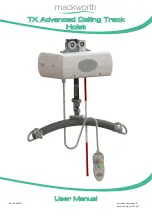
EUROBLOC
GENERAL OVERHAUL INSTRUCTIONS
6/69
This document and the information contained herein, is the exclusive property of Verlinde S.A.S. and represents a non-public, confidential and proprietary trade secret that
may not be reproduced, disclosed to third parties, altered or otherwise employed in any manner whatsoever without the express written consent of Verlinde S.A.S.
Copyright © (2013) Verlinde S.A.S. All rights reserved.
09/2016
2 GENERAL INTRODUCTION
2.1
Foreword: About this manual
This manual offers guidance to enable safe and efficient service. See “Service Manual for Hoist” for more detailed
disassembly and reassembly instructions.
Taking the time to read this manual helps you to prevent damage to the product, and, most importantly, personnel
that are situated close to it. The product is safe when used correctly. However, there are many potential hazards
associated with incorrect operation and these can be avoided when you know how to recognize and anticipate
them.
This manual is not intended as a substitute for proper training but provides recommendations and methods for safe
and efficient service.
2.2
Symbols used in this manual
Readers should familiarize themselves with the following symbols which are used in this manual.
Indicates items which require special attention by the reader. There is no obvious risk of injury associated with
notes.
2.3
Safety Alert Symbols and Signal Words
The following symbols are used in this manual to indicate potential safety hazards.
Obey all safety messages that follow this symbol to avoid possible injury or
death.
CAUTION
Indicates a potentially hazardous situation, which if not avoided, MAY result in
minor or moderate injury. It may also be used to alert against unsafe practices.
WARNING
Indicates a potentially hazardous situation, which if not avoided, COULD result
in death or serious injury.
DANGER
INDICATES AN IMMINENTLY HAZARDOUS SITUATION WHICH, IF NOT
AVOIDED, WILL RESULT IN DEATH OR SERIOUS INJURY.
CAUTION
Addresses situations not related to personal injury, such as likely or possible
damage to equipment.
Shall
Indicates that a rule is mandatory and must be followed.
Should
Indicates that a rule is a recommendation, the advisability of which depends on the facts in each situation.






























